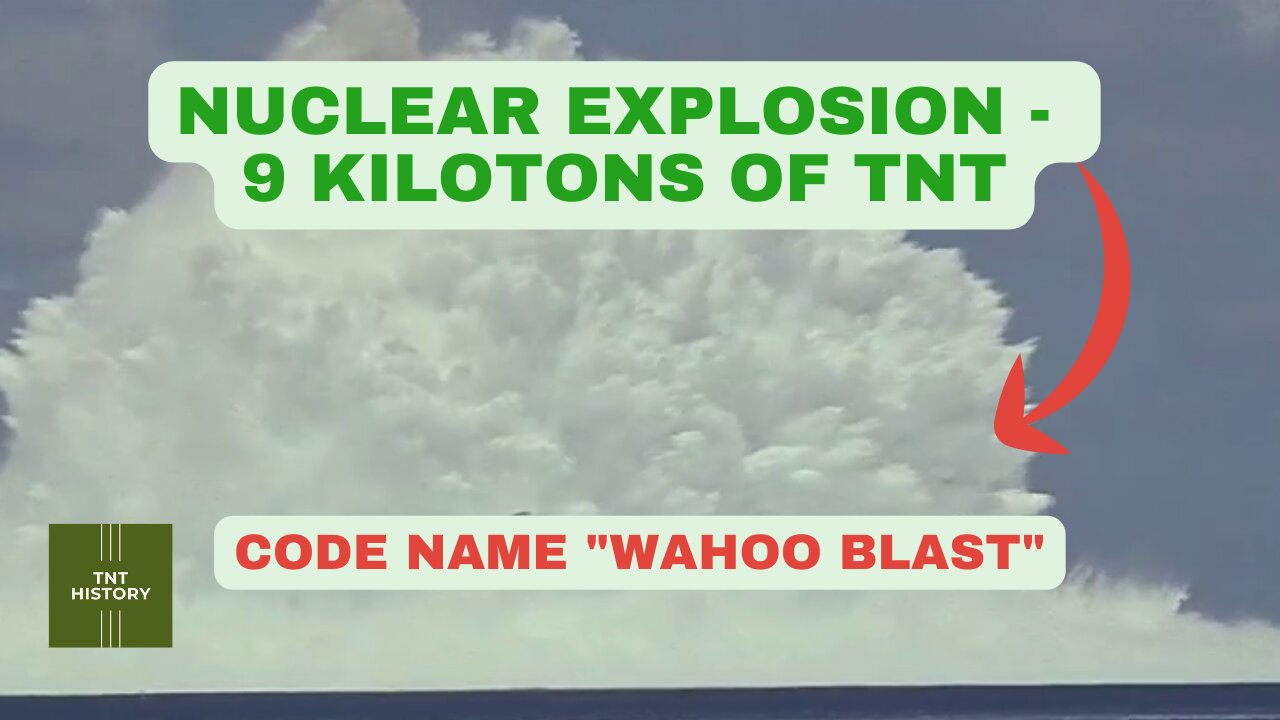Premium Only Content

The 1958 Wahoo Blast 🌋: Witness the Unbelievable Nuclear Explosion
On May 16, 1958, under the code name "Wahoo Blast," the conditions for testing a nuclear device were successfully met. Upon detonation, a remarkable sequence of events unfolded. Within one second of the blast, a towering spray dome emerged, soaring to an impressive height of 840 feet (260 meters) in just seven seconds. This spray dome exhibited a distinct cone-like shape, characterized by steep 45-degree sloped sides.
After a mere six seconds, plumes forcefully broke through the spray dome in all directions. The vertical plume continued its ascent for a full 12 seconds following the detonation, while the lateral plumes traveled horizontally for a remarkable 20 seconds before eventually collapsing. At the 20-second mark, the diameter of the spray dome had expanded to an approximate span of 3,800 feet (1,200 meters) 4.
Simultaneously, the base surge extended outward in the downwind direction, covering an impressive radius of 8,000 feet (2,400 meters) a mere 1.7 seconds after the blast. Fueled by a 15-knot (17 mph; 28 km/h) wind, this base surge achieved speeds of up to 21 knots (24 mph; 39 km/h). Its imposing presence endured for three and a half minutes, remaining visible even longer from an aerial perspective as it continued to traverse across the ocean.
As the spray dome and base surge gradually dissipated, an intriguing foam patch began to spread from the water's surface at ground zero, eventually encompassing a vast area exceeding 6,000 feet (1,800 meters) 4.
The nuclear explosion was calculated to have had a yield of 9 kilotons of TNT (38 TJ). Remarkably, all fallout remained within the predicted fallout area, with the maximum recorded radiation level reaching 0.030 R/hr. The target ship positioned 5,900 yards (2.9 nautical miles; 3.4 miles; 5.4 kilometers) from the epicenter endured a direct hit from the shockwave, causing intense vibrations throughout the entire vessel and violent shaking. Meanwhile, a Moran merchant marine ship, located at a distance of 2,346 feet (715 meters), suffered immobilization due to shock-induced damage to its main and auxiliary equipment, along with minor damage to its hull.
Approximately one hour and ten minutes after the detonation, a water sample taken directly above the blast site displayed a radiation level of 5 R/hr. The retrieval team ventured into a field with a radiation level of 3.8 R/hr an hour and thirty-five minutes after the explosion occurred.
✅ Express your opinions and be heard by signing up on YouGov.com.
YouGov: https://bit.ly/Signup-on-YouGov
🐦 Follow TNT History on Twitter: https://twitter.com/history_tnt
✅ Hostinger.com Everything You Need to Create a Website - Up to 75% off Hosting
https://bit.ly/Hostinger-75-Percent
Visit Jadesales.shop for Reliable and Affortable Products - Free Shipping on Orders over $45
Electronics: https://bit.ly/Electronic-Collection
Health Products: https://bit.ly/Health-Items
School Supplies: https://bit.ly/Jade-Sales-School-Supplies
-
 11:25
11:25
Film Threat
19 hours agoLET'S DISCUSS THE 2025 OSCAR NOMINATIONS | Film Threat News
21.8K8 -
 13:07
13:07
DEADBUGsays
4 hours agoThe Southport Massacre, The Great British Cover-Up
22.5K13 -
 25:26
25:26
hickok45
7 hours agoSunday Shoot-a-Round # 265
19.3K26 -
 30:55
30:55
Tundra Tactical
18 hours ago $17.32 earnedFaith, Family, Gun Rights : Tundra Tactical Interviews Erich Pratt Vice President Of GOA
99.6K29 -
 24:08
24:08
MYLUNCHBREAK CHANNEL PAGE
1 day agoUnder The Necropolis - Pt 4
236K77 -
 1:26:44
1:26:44
Tactical Advisor
1 day agoTrump Starting Strong/Shot Show Recap | Vault Room Live Stream 015
127K10 -
 49:13
49:13
SGT Report
1 day agoGILDED CAGE: A.I. PRODUCED MRNA VACCINES & THE ROAD TO HELL -- Sam Anthony
78.9K407 -
 17:00
17:00
BIG NEM
17 hours agoI Spent 10 Years Making a Movie About a 40 Year Old VIRGIN
12.4K1 -
 17:01
17:01
RealitySurvival
13 hours agoRussia's Anti-Satellite Weapon Could Disable Your Commuter Car!
9.56K -
 4:13:39
4:13:39
Nobodies Gaming
20 hours ago $46.23 earnedNobodies : Rumble Gaming MARVEL RIVALS
257K11